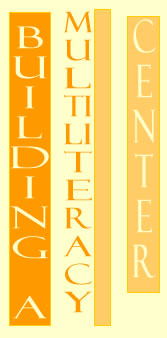

Assessing
Multimodal Projects
KHM: Did the instructor build in some kind of peer evaluation for
this group project?
DS:
In projects like this, where students are doing multimodal communication,
I think assessment is its own challenge. We really need to re-think what
assessment means in this context. You're talking about an instructor who
is not formally trained in graphic design or in visual communication.
And, as someone who is providing support for him, I'm not formally trained
in visual communication and in design. My training and his training are
in writing instruction and how to assess writing in the narrower sense
of the word.
George and I were put in this situation of having to assess multimodal compositions that were visually intensive, and were actually not just visually intensive but used animation and were Flash-based. And we had no formal training in assessing these kinds of compositions. We could look at something and say, "Yes, it looked professional," or, "It looked effective," or, "It seemed practical," but we couldn't draw on the same kind of authority that, say, a graphic designer would be able to. So, these kinds of projects seemed to me to call for different models for assessment.
What we ended up doing was really focusing on the student's ability to reflect on what he or she had done. So we built in informal reflective writing about the web design, so that a student could say, "Here's what I think I accomplished, here's what I was trying to do, here's what I would do differently," and we could assess that. And we could also just assess the fact that something was done, that websites got done, that certain aspects of the project were fulfilled. So we could say, "Ok, these students did produce a website. It did address certain needs of the non-profit, it did have certain components to its navigation scheme." And these things had all been proposed at an earlier time in the course and had been approved by us and by the non-profits anyway. And we had said, "Ok, this looks like a good direction to go in," and we could say, "Students did make good on this promise." And then they were able to reflect on it.
I
suppose it could have happened that we got really poorly designed sites,
and then we would have had to somehow address that in our assessments.
After a certain point, I think that George and I would feel confident
in saying, "This is just not very well done and your assessment is
going to reflect that. It doesn't matter how much reflection you do on
that, you didn't come through." But that didn't happen in this case.
I think that the design choices students made were, by and large, effective.
We didn't intensively use peer evaluation or the evaluation of the clients
of the non-profit groups themselves. And if we were going to do a course
like this again, we would build those components more heavily into the
assessment process -- Do almost a kind of usability study, where peers
and the non-profit organizations go to the website and evaluate different
components of it, and have that be a component of assessment.
After all, though, it is a freshman writing course, and obviously we're
comfortable in broadening the definition of writing to include multimodal
compositions. But I don't know that we want to get in the position of
saying, "Well, you created an ugly graphic for this page, and therefore,
you're going to get a C in the class." I just don't think that that's
appropriate for this context. There's a reason we're doing this as a freshman
writing class. It's not a graphic design class and it's not a multimedia
authoring class. It's a writing class. And we're starting from the point
of view of writing using that as a foundation and branching out.
Top | Next
"What we ended up doing was really focusing on the student's ability to reflect on what he or she had done. So we built in informal reflective writing about the web design, so that a student could say, "Here's what I think I accomplished, here's what I was trying to do, here's what I would do differently," and we could assess that. And we could also just assess the fact that something was done ... that certain aspects of the project were fulfilled."